The tale of how the spectral characteristics of lighting affect our lives
Citizens readers, techies and humanities, you are in danger, immediately go outside under the warm summer sun (if the weather allows), this is not an educational alarm! I repeat this is not a training alert! Well, if others do not appreciate your attempt to evacuate, then settle in and let's talk with you about lighting. In a nutshell, an article about the impact of domestic (internal) lighting on our body. I will try not to overload the article with technical information, for all inquisitive colleagues I will leave the appropriate links. However, we can’t do without schedules (I love them simply). The article turned out to be a long one, so in the end I decided that we would consider first of all the spectral characteristics of lighting ( here more ).
So, imagine, friends, that an average person lives somewhere in the world, let's call him Vasily. And so Vasily lived for 20 years, lived on the edge of a forest in the middle lane of our endless homeland, but he wanted “coffee from the best barista”, sweatshirts, and “iPhones” glossy, and Vasily decided to go to town. And so that he would not have a sweet life at all, he decided to go to the office on the ground floor in the glorious city of Murmansk, well, in general, to the "concrete office box", so that he would work hard not to see the light of God.
But what was waiting for Vasily there, hidden under the cut, we ask all inquisitive graces.
The article will be large and in terms of meaning will be divided into three parts
1 - Spectral characteristics of light sources
2 - How to measure the spectrum with straight hands and the “blue electrical tape”
3 - Briefly about the effect of light on a person

* Notes The spectra presented in the article, due to technical limitations, may differ from actual light sources, if you want to check it yourself.
To begin, consider the main points
1. Prior to the massive introduction of electrical sources of light into everyday life, mankind has largely adjusted its life activity (daily cycle) to natural lighting.
2. Natural lighting changes throughout the day, its radiation spectrum is continuous, the sun shines in the ultraviolet, visible, and infrared ranges. natural light does not have ripple.
3. A modern person usually spends a good 90% of his time indoors (transport will also be considered an artificial environment)
4. On the premises people often use artificial lighting (or combined), even on a summer day not everyone has the opportunity to use only natural lighting
5. Light affects biological processes in the human body.
This is how the spectrum of the sun looks like with a “rainbow” and a graph. Someone faithfully photographed the Moscow sky.
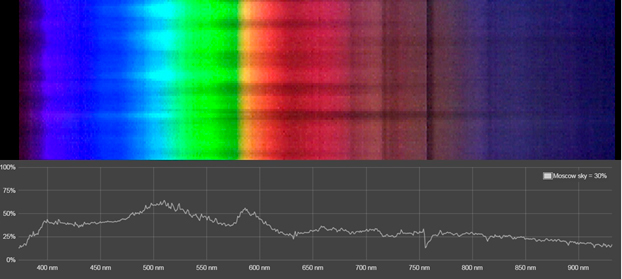
There is still something.
Let's go back to Vasily. As we recall, he spent almost his entire conscious life in nature, we will see how the sun shone for him, and why thorns quickly grew from him in hedgehogs.
Responsible men engaged in lighting technology have made for us a model of conventional daylight of various color temperatures (this is xls in which you can simulate don't be afraid), we will imagine that in the early morning the sun shone with a temperature of 4000K in the early morning, at 5500K at noon and 7000K in the afternoon, well and by night moved in the opposite order (approximate color temperature of light sourceshere ).
But such a tidy sun shone for a very, very long time, what can wait for our hero who has fallen into the "concrete box"?
Considering that the majority of people employed in work not related to production are unlikely to sit in rooms similar to category "A" offices, many (and in particular) are waiting for them.

Cheap fluorescent lamps with electromagnetic ballasts, for example LB-40 with a color rendering index (the ability to correctly reproduce colors) CRI <70.
Perhaps they will be more expensive overseaseggplants , lamps from Osram or Philips with CRI> 80, well, and since the schedule at my fingertips was also full for compact CFL fluorescent lamps, we also mention them.
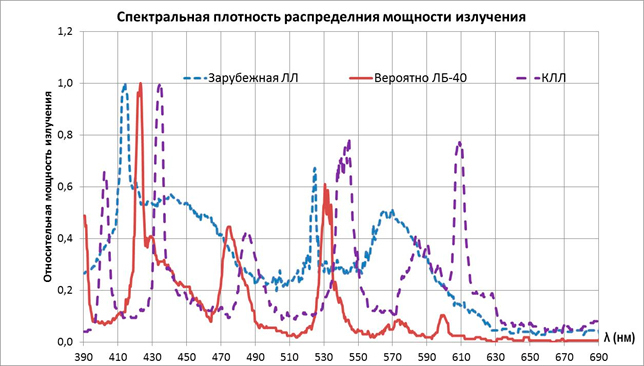
Pictures with a "rainbow" under the spoiler, I recommend to see, and compare with the Moscow sky presented above, will be very clear.
So, what we see, we see the dream of any climber and a way to test friends according to the method of V. Vysotsky, namely mountains and peaks, and the cheaper the lamp, the more “Himalayas” we observe.
What does this tell us? This tells us first of all that light is not at all as natural. And when you consider that our experimental Vasily is forced to sit under completely unchanged light for all his 8 working hours. Remember the chart above? Natural light changes throughout the day, but this one is not at all. Thus, our body suffers from being under unusual lighting. What is associated with a deterioration in health, a decrease in visual working capacity and labor productivity. Do not believe me? Ask the wisest Julian Borisovich Eisenberg ( reference book on lighting technology p. 889 ).
Where is the exit, perhaps LED lighting?
Well, perhaps not quite. Although, it’s already much better.
We look at the charts and all the same, "your spectrum is not at all like your mother." Anyway, there is a peak in the blue region, a failure in the blue region, and again, I remind you that most LED lamps shine in the same colors throughout the day.
I don’t have pictures for RGB LEDs at hand, but believe me that the situation there is no better (and perhaps usually even worse).
measurements by what was at hand a

picture from the Internet A
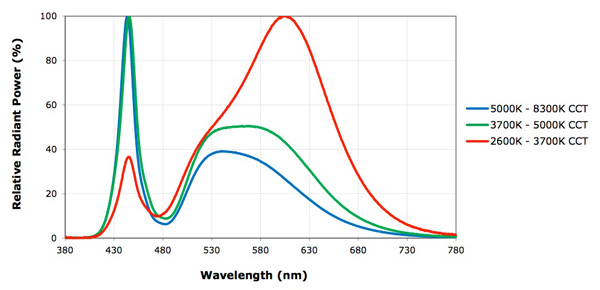
spectrum of warm white LEDs under the spoiler.
So, Vasily plowed his 8 hours, returned home and, tired of the official lamps, comes home to sit on the sofa and plunges into the warm lamp light.
And by the way, this is not so bad for evening home lighting, an incandescent lamp remains a good option. The spectrum of an incandescent lamp largely corresponds to the spectrum of the evening sun, and does not greatly inhibit the production of melatonin (more on this later), again one minus is not regulated during the day.
Range of bulbs under the spoiler:
Vasily sat at home, thought, thought, decided that he would no longer harm his health, he would become anoblewoman's pillar freelancer and would control the white light as he wanted while working at home.
And this, by the way, is not a bad option, despite the fact that modern dimmable LED lamps still do not give complete identity to natural lighting, it is still better than the aforementioned LB-40 and can even be slightly better than just LED lamps. Moreover, if RGBW lamps are more of a pampering, then lamps based on LEDs of warm white and cold white light are quite suitable for lighting. If interested, you can look this way
At least such a lamp can stepwise simulate warm white, neutral white and cold white light. (under the spoiler) That poorly fits poorly with the natural solar cycle.
Spectra of the lamp ML-19 Dual White E27 ball 9W (color temperature based on manufacturer data)
Somehow I already raised this topic on Habré . But, I think, it is worth telling in brief.
So, we fired up with rainbow pictures and decided to start measuring the spectrum everywhere. Since the cheapest spectrometer in the Russian Federation costs more than 70 tr (at the time of writing), then we will go the other way.
There are such wonderful guys from the portal http://publiclab.org/ , they have a lot of interesting open science there and so on. But we are interested in homemade spectrometers.
By the way, there are several types of spectrometers, and you can either buy a ready-made kit for assembly (I recommend a lopsided type of me), and assemble it yourself from the means at hand.
Since I am sure that if you read up to this place, then your eyes are already burning, your hands are itching and waiting for the parcel due to the unfriendly ocean, you do not want and you won’t.
So, what will we need and what will we do:
1. We take preferably A4 thick drawing paper (Whatman) or thick matte photo paper, in general, thicker paper the denser the better, but I think if you are very persistent you can try to make it out of plain truth flimsy, (in principle, if you are friends with drawing, you can even make from shoe cardboard at least textolite, but I’m a krivoruk and tell my way with thick paper.
2. Printer and assembly diagram, print out the diagram and instructionson the sheet and then joyfully cut, cutting through the necessary holes (it is better to cut the gap with a sharp scalpel or blade, you need accuracy).
We take a DVD (you can also have a CD, but the diffraction grating is worse there) we cut it in half with scissors, take one half and carefully divide it into two layers, we need a transparent layer of photoresist, we need to cut a square of diff from it. Lattices for our paper blank. You can see more details here .
3. Next, we collect all the parts together. I used a simple adhesive pencil, and the differential. fastened the grating with electrical tape (although double-sided tape is preferable), we look at what happened, and it turned out to be a fragile translucent structure, so if the paper was originally dense, we can happily reinforce it with electrical tape until we get Malevich’s blue or black square, as a result, our The spectroscope must not transmit any light except light through the gap.
4. We take preferably the old unnecessary phone (no, well, in principle, you can take any). And we glue our design to its body, having previously determined where we will stick it, so that the spectrum normally gets into the camera. Of course, you can not stick it and apply it every time, but this is inconvenient and the spectra will often move out. By the way, it’s not at all necessary to attach it to the phone, you can also connect it to a web camera, as you prefer. In the photo there is a home-made spectrometer (glued), and two of the sets the first one is the same but from the set, the second one is similar in principle to the plastic (quality is better):
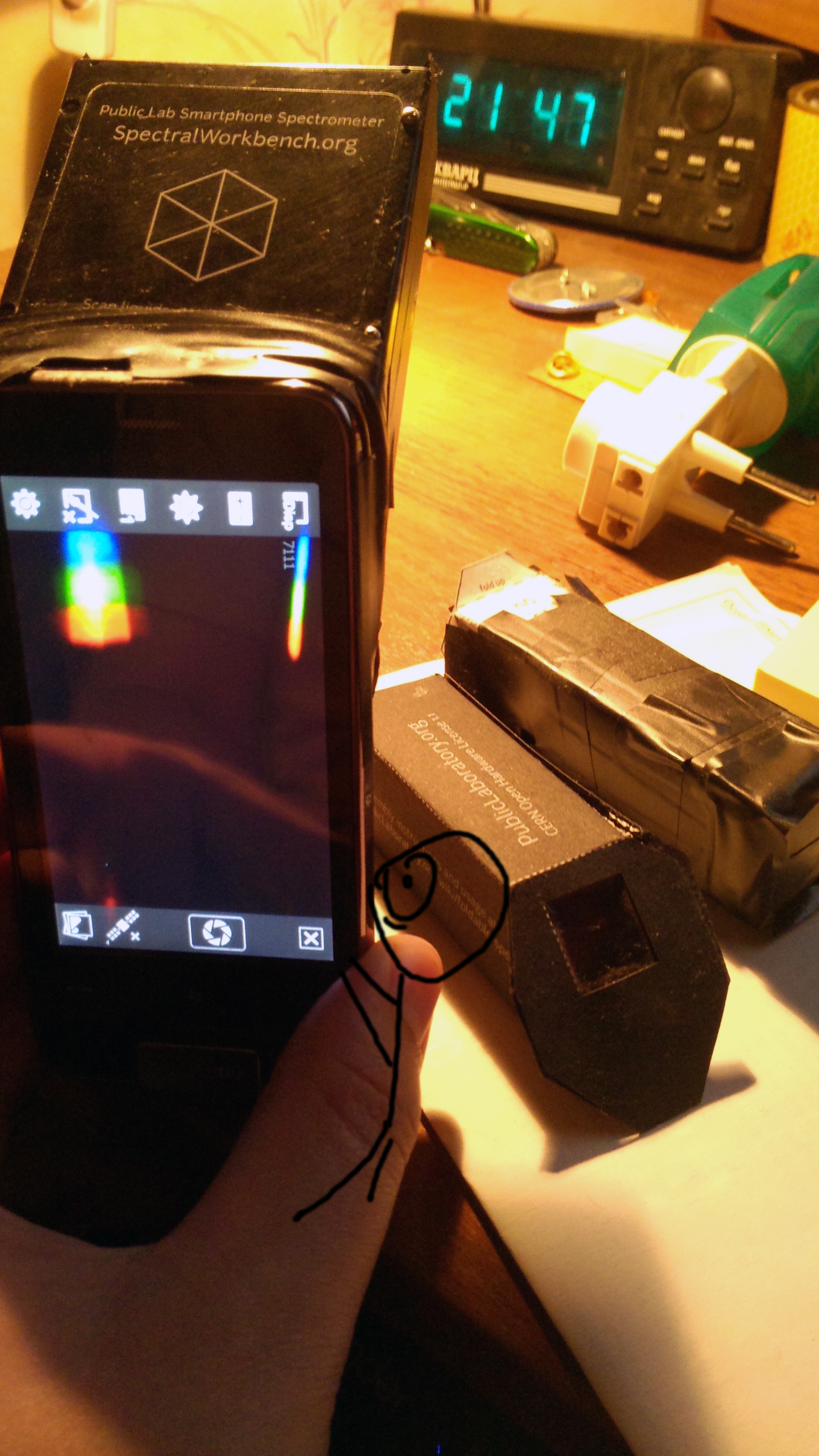
5. Be sure to go take a spectrum of a compact fluorescent lamp (CFL)or at worst the usual fluorescent lamp, and then everything that suits your soul After we photographed all the spectra that we wanted. They need to be processed, it is possible in any graphics editor. I usually crop and center if necessary. Since the calibration method (about this below) provides a comparison with the standard, it is necessary that all the stripes of the spectrum in all the pictures are in the same place (as far as possible) or in the end you get that the computer will perceive the shifted image as light from another wavelength.
6. Register on the portal, click capture spectra upload and first of all we upload our CFL image there, we need it for calibration after the image has loaded and the spectrum image has opened, we may need to carry out a number of manipulations
6.1 If the image does not lie horizontally if the violet-blue zone does not lie on the left, and red-orange on the right means you need to click more tools and use the rotation and reflection tools to rotate the spectrum as we need. after which I recommend Pressing the “re extract from foto (in the same tools) button after that, the computer will build a curve for us that will be consistent with the picture of the spectrum, though we do not have enough wavelengths.
6.2 You can adjust the spectrum graph by automatically selecting the brightest spectrum (in the more tools menu) or manually by selecting set sample row and clicking on the most successful section of the spectrum in the image.
6.3 Click the calibrate button, click begin and on the chart click on the top of the middle blue spectrum (as in the example in the instructions), then also select the green maximum. Now we have a calibrated standard. This standard can be applied to drawings uploaded and processed according to clause 6.1. after which they will also have a wavelength scale.
6.4 You can apply the calibration to any image by clicking calibrate-> use existing calibration and selecting your standard, but remember that if you have a spectrometer attached to the camera that has peeled off for example, then the error may be large and you will need to recalibrate.
6.5. Further and further data can be taken in different formats and plotted, for example, in Excel, this is certainly not the most accurate method, but much better than nothing at all due to the skill you can get pictures that correlate with reality.
For dessert, very briefly about the effect of light on a person.
Light acts on the circadian rhythms of a person.
Light, especially in the blue region, is able to suppress the production of melatonin, the hormone responsible for our quiet recovery, the less melatonin we experience, the better it is, on the one hand it will cheer up, on the other hand, it will break your biorhythms in the late evening and before going to bed. it will be harder for you to fall asleep and your sleep efficiency will be lower. It should be noted that the power of the light source (luminous flux), the time spent under it, as well as the age (children are more susceptible, older people are much less) is certainly important.
The picture shows one of the averaged dependences of the degree of suppression of melatonin on the radiation wavelength, there are other variations on the topic of this function, you can search in the corresponding sources.
Lighting Magazine No. 3 for 2012 .
In short, to calm down it is better to use warm colors (incandescent lamps, LED lamps with a remote phosphor).
To cheer up it is better to use fluorescent lamps:
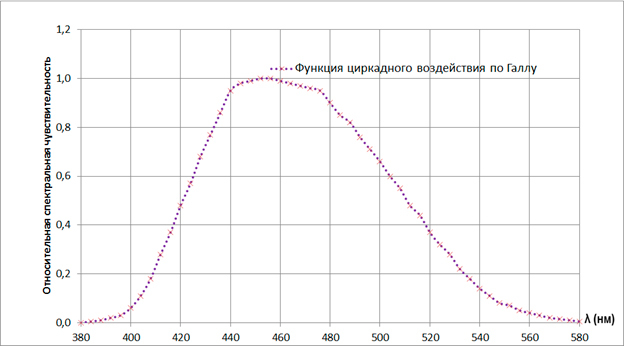
In addition to circadian exposure. light also has a negative effect on the organs of vision, excess blue light causes damage to the eyes, again, children are especially susceptible (an article on this in the same issue of lighting), so you should not look at LED or fluorescent lamps for cold white light for a long time.
Also an important factor, natural light contains ultraviolet radiation,
which contributes to the production of vitamin D, anti-rachitic effect, well, and simply activates secret photobiological processes in the human body.
It should be noted that only UV-A passes through the window glass, and artificial light sources are usually not designed to cover the deficit of UV radiation and either do not emit UV at all or it is a by-product not designed to eliminate light starvation.
So if you sit a lot in "concrete boxes", it will be useful sometimes to be irradiated with the appropriate UV lamps, or just go out for a walk.
Read more about the effects of light here .
Well, that’s like it’s all, the article turned out to be a big one, I think that I’ll not master something soon, so thanks to everyone who read, take care of your health.
So, imagine, friends, that an average person lives somewhere in the world, let's call him Vasily. And so Vasily lived for 20 years, lived on the edge of a forest in the middle lane of our endless homeland, but he wanted “coffee from the best barista”, sweatshirts, and “iPhones” glossy, and Vasily decided to go to town. And so that he would not have a sweet life at all, he decided to go to the office on the ground floor in the glorious city of Murmansk, well, in general, to the "concrete office box", so that he would work hard not to see the light of God.
But what was waiting for Vasily there, hidden under the cut, we ask all inquisitive graces.
The article will be large and in terms of meaning will be divided into three parts
1 - Spectral characteristics of light sources
2 - How to measure the spectrum with straight hands and the “blue electrical tape”
3 - Briefly about the effect of light on a person

* Notes The spectra presented in the article, due to technical limitations, may differ from actual light sources, if you want to check it yourself.
Part 1 - spectral characteristics of light sources
To begin, consider the main points
1. Prior to the massive introduction of electrical sources of light into everyday life, mankind has largely adjusted its life activity (daily cycle) to natural lighting.
2. Natural lighting changes throughout the day, its radiation spectrum is continuous, the sun shines in the ultraviolet, visible, and infrared ranges. natural light does not have ripple.
3. A modern person usually spends a good 90% of his time indoors (transport will also be considered an artificial environment)
4. On the premises people often use artificial lighting (or combined), even on a summer day not everyone has the opportunity to use only natural lighting
5. Light affects biological processes in the human body.
This is how the spectrum of the sun looks like with a “rainbow” and a graph. Someone faithfully photographed the Moscow sky.

There is still something.
Let's go back to Vasily. As we recall, he spent almost his entire conscious life in nature, we will see how the sun shone for him, and why thorns quickly grew from him in hedgehogs.

Responsible men engaged in lighting technology have made for us a model of conventional daylight of various color temperatures (this is xls in which you can simulate don't be afraid), we will imagine that in the early morning the sun shone with a temperature of 4000K in the early morning, at 5500K at noon and 7000K in the afternoon, well and by night moved in the opposite order (approximate color temperature of light sourceshere ).
But such a tidy sun shone for a very, very long time, what can wait for our hero who has fallen into the "concrete box"?
Considering that the majority of people employed in work not related to production are unlikely to sit in rooms similar to category "A" offices, many (and in particular) are waiting for them.

Cheap fluorescent lamps with electromagnetic ballasts, for example LB-40 with a color rendering index (the ability to correctly reproduce colors) CRI <70.
Perhaps they will be more expensive overseas

Pictures with a "rainbow" under the spoiler, I recommend to see, and compare with the Moscow sky presented above, will be very clear.
look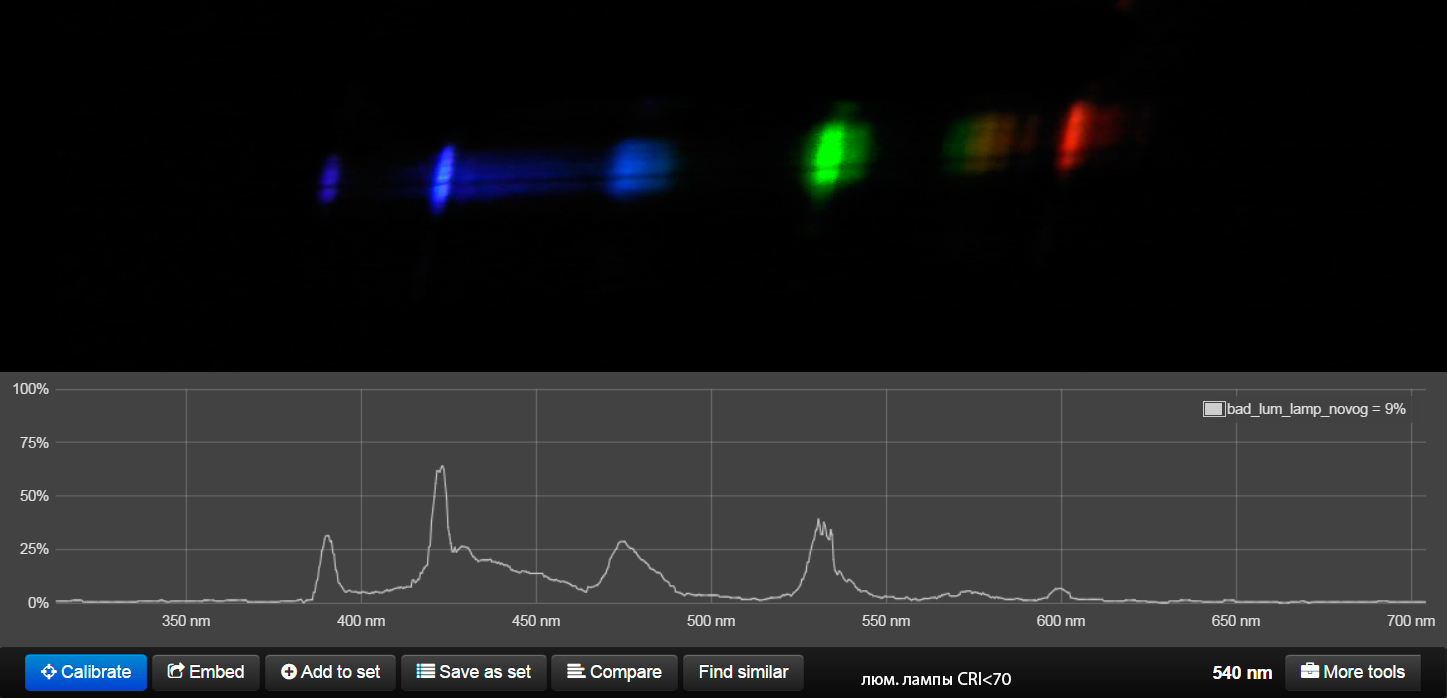
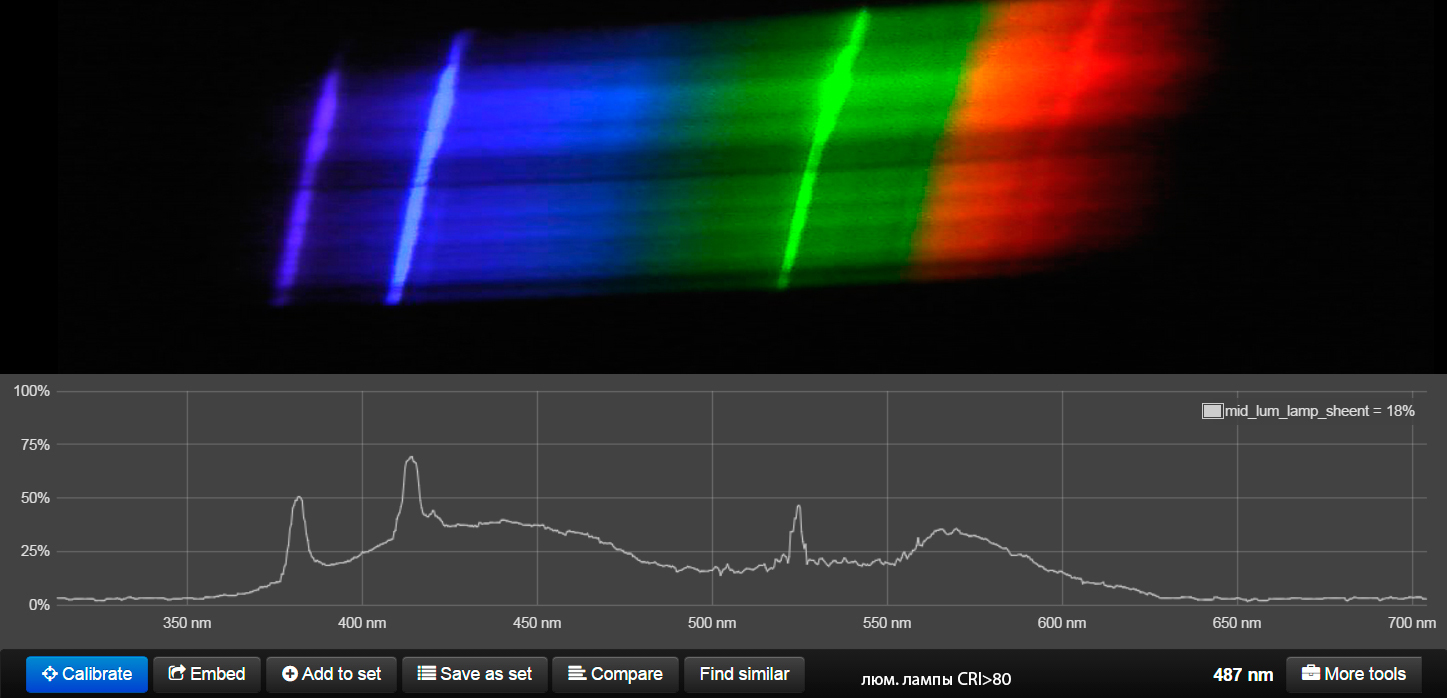
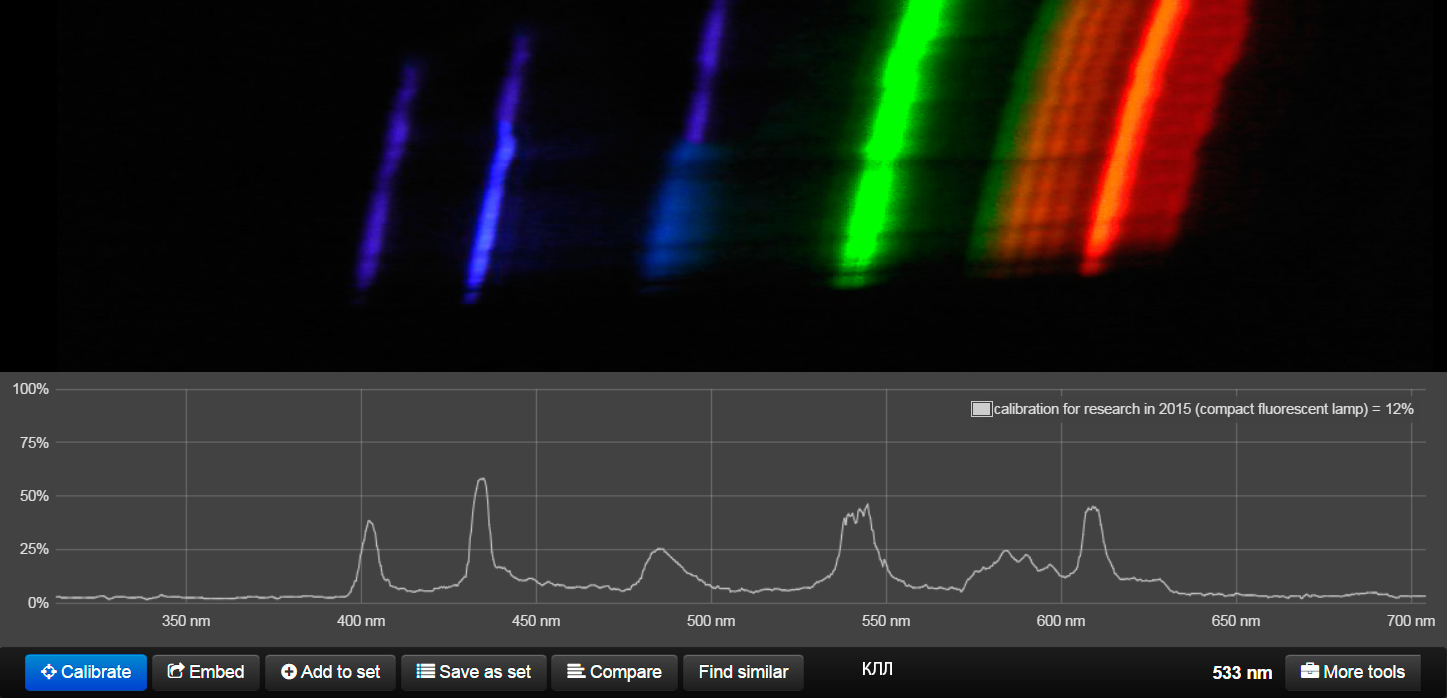



So, what we see, we see the dream of any climber and a way to test friends according to the method of V. Vysotsky, namely mountains and peaks, and the cheaper the lamp, the more “Himalayas” we observe.
What does this tell us? This tells us first of all that light is not at all as natural. And when you consider that our experimental Vasily is forced to sit under completely unchanged light for all his 8 working hours. Remember the chart above? Natural light changes throughout the day, but this one is not at all. Thus, our body suffers from being under unusual lighting. What is associated with a deterioration in health, a decrease in visual working capacity and labor productivity. Do not believe me? Ask the wisest Julian Borisovich Eisenberg ( reference book on lighting technology p. 889 ).
Where is the exit, perhaps LED lighting?

Well, perhaps not quite. Although, it’s already much better.
We look at the charts and all the same, "your spectrum is not at all like your mother." Anyway, there is a peak in the blue region, a failure in the blue region, and again, I remind you that most LED lamps shine in the same colors throughout the day.
I don’t have pictures for RGB LEDs at hand, but believe me that the situation there is no better (and perhaps usually even worse).
measurements by what was at hand a

picture from the Internet A

spectrum of warm white LEDs under the spoiler.
look

So, Vasily plowed his 8 hours, returned home and, tired of the official lamps, comes home to sit on the sofa and plunges into the warm lamp light.
And by the way, this is not so bad for evening home lighting, an incandescent lamp remains a good option. The spectrum of an incandescent lamp largely corresponds to the spectrum of the evening sun, and does not greatly inhibit the production of melatonin (more on this later), again one minus is not regulated during the day.
Range of bulbs under the spoiler:
Watching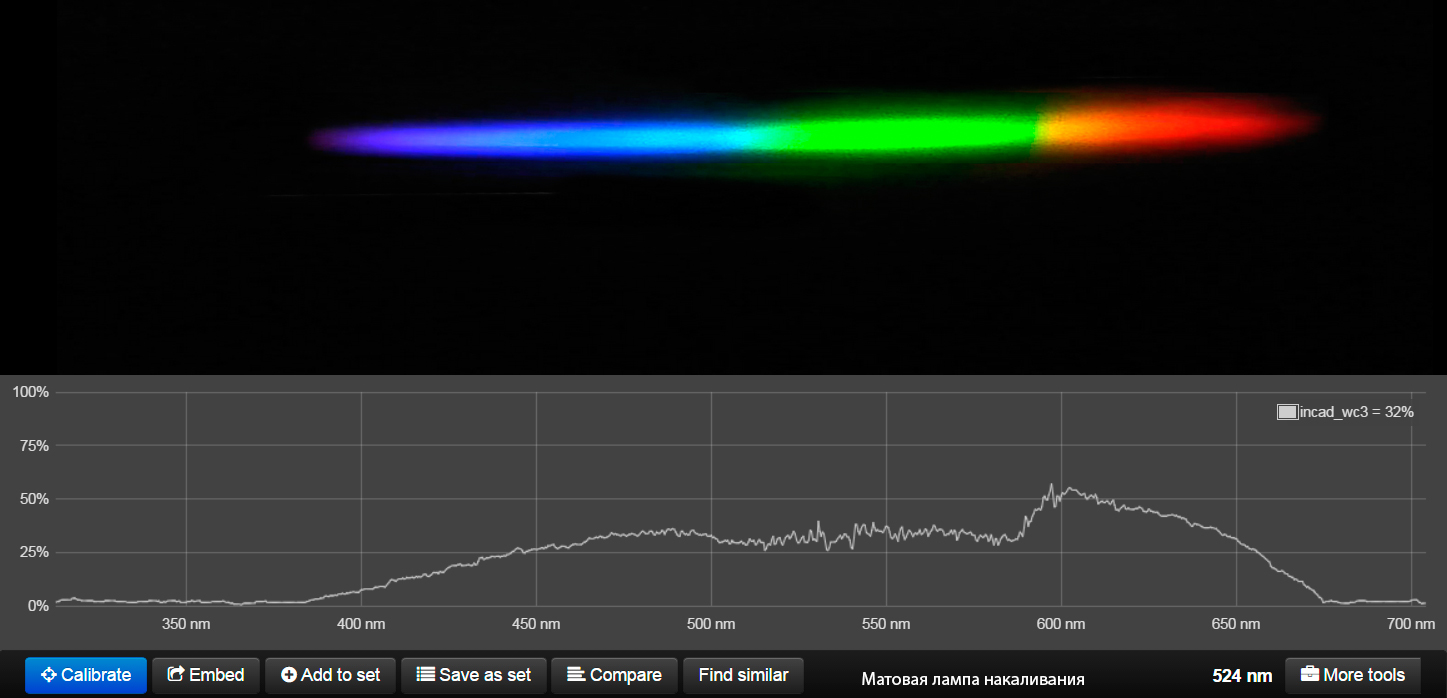

Vasily sat at home, thought, thought, decided that he would no longer harm his health, he would become a
And this, by the way, is not a bad option, despite the fact that modern dimmable LED lamps still do not give complete identity to natural lighting, it is still better than the aforementioned LB-40 and can even be slightly better than just LED lamps. Moreover, if RGBW lamps are more of a pampering, then lamps based on LEDs of warm white and cold white light are quite suitable for lighting. If interested, you can look this way
At least such a lamp can stepwise simulate warm white, neutral white and cold white light. (under the spoiler) That poorly fits poorly with the natural solar cycle.
Spectra of the lamp ML-19 Dual White E27 ball 9W (color temperature based on manufacturer data)
look
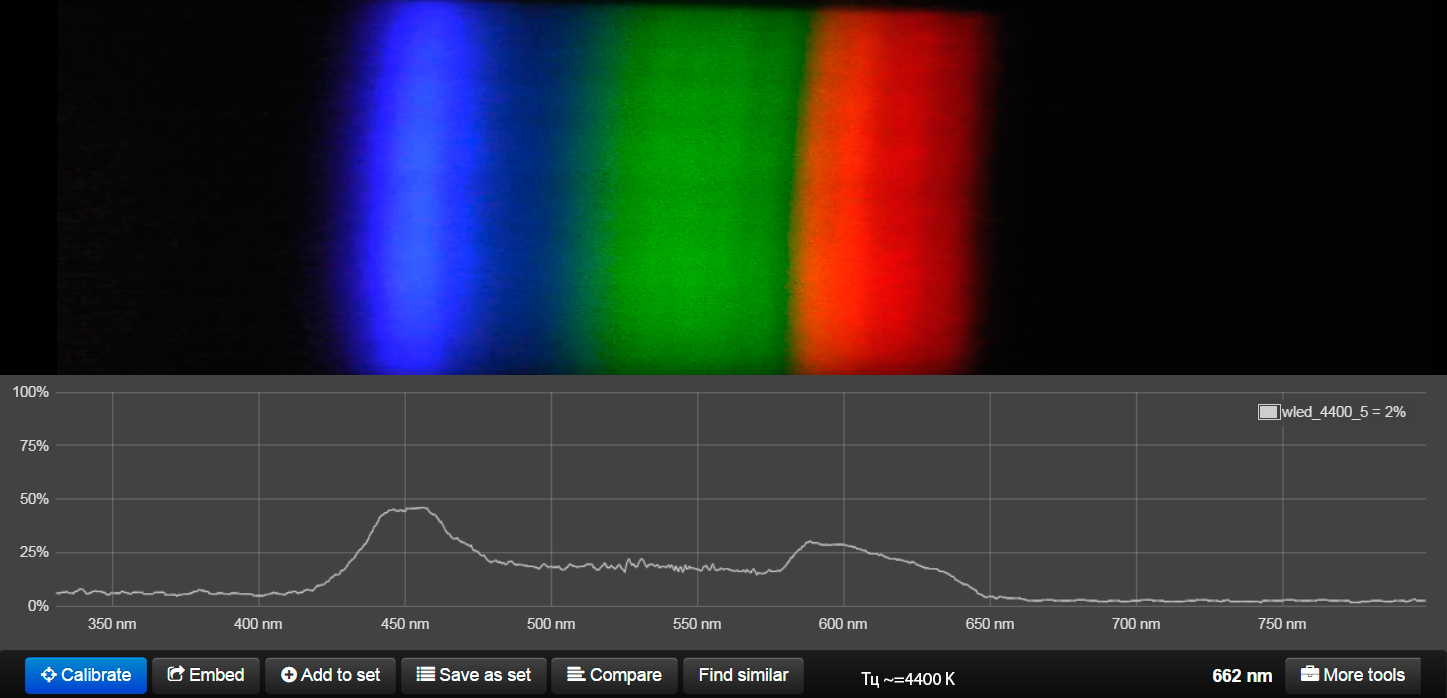
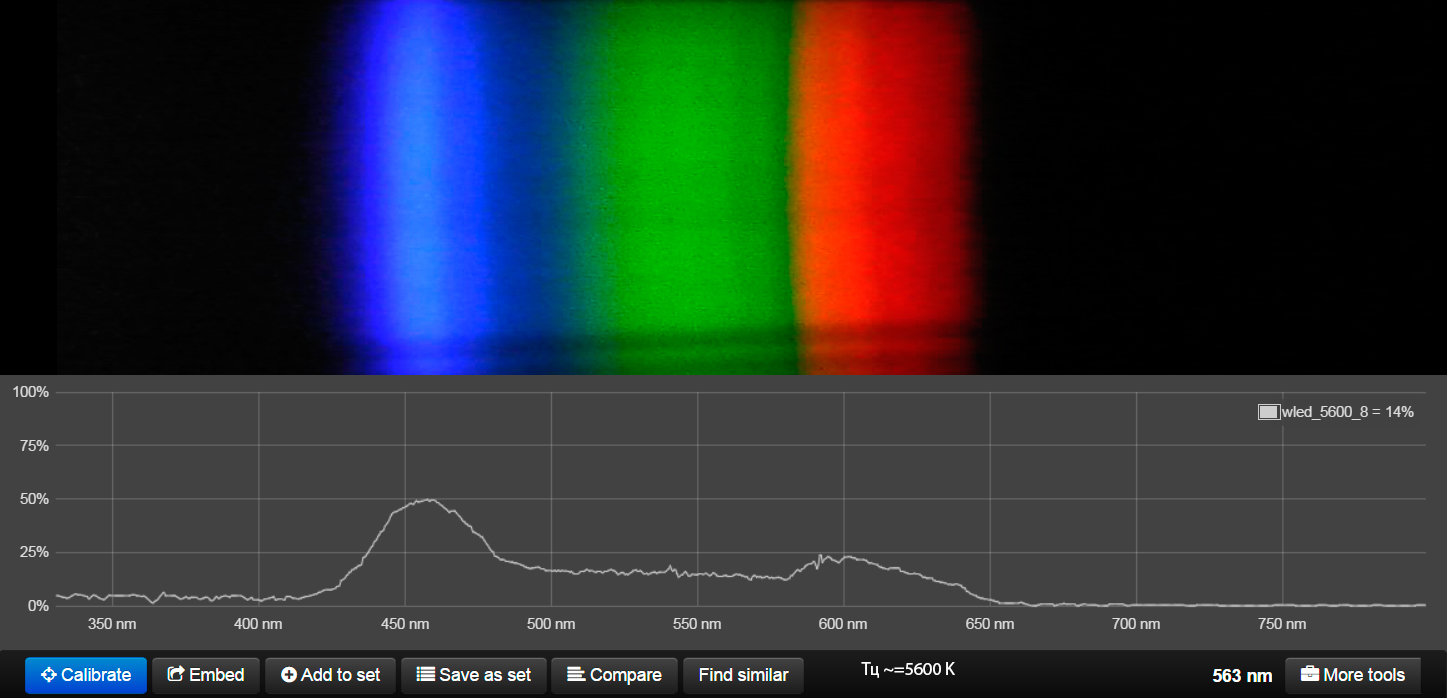



Part 2 - how to measure the spectrum with straight hands and blue electrical tape
Somehow I already raised this topic on Habré . But, I think, it is worth telling in brief.
So, we fired up with rainbow pictures and decided to start measuring the spectrum everywhere. Since the cheapest spectrometer in the Russian Federation costs more than 70 tr (at the time of writing), then we will go the other way.
There are such wonderful guys from the portal http://publiclab.org/ , they have a lot of interesting open science there and so on. But we are interested in homemade spectrometers.
By the way, there are several types of spectrometers, and you can either buy a ready-made kit for assembly (I recommend a lopsided type of me), and assemble it yourself from the means at hand.
Since I am sure that if you read up to this place, then your eyes are already burning, your hands are itching and waiting for the parcel due to the unfriendly ocean, you do not want and you won’t.
So, what will we need and what will we do:
1. We take preferably A4 thick drawing paper (Whatman) or thick matte photo paper, in general, thicker paper the denser the better, but I think if you are very persistent you can try to make it out of plain truth flimsy, (in principle, if you are friends with drawing, you can even make from shoe cardboard at least textolite, but I’m a krivoruk and tell my way with thick paper.
2. Printer and assembly diagram, print out the diagram and instructionson the sheet and then joyfully cut, cutting through the necessary holes (it is better to cut the gap with a sharp scalpel or blade, you need accuracy).
We take a DVD (you can also have a CD, but the diffraction grating is worse there) we cut it in half with scissors, take one half and carefully divide it into two layers, we need a transparent layer of photoresist, we need to cut a square of diff from it. Lattices for our paper blank. You can see more details here .
3. Next, we collect all the parts together. I used a simple adhesive pencil, and the differential. fastened the grating with electrical tape (although double-sided tape is preferable), we look at what happened, and it turned out to be a fragile translucent structure, so if the paper was originally dense, we can happily reinforce it with electrical tape until we get Malevich’s blue or black square, as a result, our The spectroscope must not transmit any light except light through the gap.
4. We take preferably the old unnecessary phone (no, well, in principle, you can take any). And we glue our design to its body, having previously determined where we will stick it, so that the spectrum normally gets into the camera. Of course, you can not stick it and apply it every time, but this is inconvenient and the spectra will often move out. By the way, it’s not at all necessary to attach it to the phone, you can also connect it to a web camera, as you prefer. In the photo there is a home-made spectrometer (glued), and two of the sets the first one is the same but from the set, the second one is similar in principle to the plastic (quality is better):

5. Be sure to go take a spectrum of a compact fluorescent lamp (CFL)or at worst the usual fluorescent lamp, and then everything that suits your soul After we photographed all the spectra that we wanted. They need to be processed, it is possible in any graphics editor. I usually crop and center if necessary. Since the calibration method (about this below) provides a comparison with the standard, it is necessary that all the stripes of the spectrum in all the pictures are in the same place (as far as possible) or in the end you get that the computer will perceive the shifted image as light from another wavelength.
6. Register on the portal, click capture spectra upload and first of all we upload our CFL image there, we need it for calibration after the image has loaded and the spectrum image has opened, we may need to carry out a number of manipulations
6.1 If the image does not lie horizontally if the violet-blue zone does not lie on the left, and red-orange on the right means you need to click more tools and use the rotation and reflection tools to rotate the spectrum as we need. after which I recommend Pressing the “re extract from foto (in the same tools) button after that, the computer will build a curve for us that will be consistent with the picture of the spectrum, though we do not have enough wavelengths.
6.2 You can adjust the spectrum graph by automatically selecting the brightest spectrum (in the more tools menu) or manually by selecting set sample row and clicking on the most successful section of the spectrum in the image.
6.3 Click the calibrate button, click begin and on the chart click on the top of the middle blue spectrum (as in the example in the instructions), then also select the green maximum. Now we have a calibrated standard. This standard can be applied to drawings uploaded and processed according to clause 6.1. after which they will also have a wavelength scale.
6.4 You can apply the calibration to any image by clicking calibrate-> use existing calibration and selecting your standard, but remember that if you have a spectrometer attached to the camera that has peeled off for example, then the error may be large and you will need to recalibrate.
6.5. Further and further data can be taken in different formats and plotted, for example, in Excel, this is certainly not the most accurate method, but much better than nothing at all due to the skill you can get pictures that correlate with reality.
Part 3 - Briefly on the effects of light on humans
For dessert, very briefly about the effect of light on a person.
Light acts on the circadian rhythms of a person.
Light, especially in the blue region, is able to suppress the production of melatonin, the hormone responsible for our quiet recovery, the less melatonin we experience, the better it is, on the one hand it will cheer up, on the other hand, it will break your biorhythms in the late evening and before going to bed. it will be harder for you to fall asleep and your sleep efficiency will be lower. It should be noted that the power of the light source (luminous flux), the time spent under it, as well as the age (children are more susceptible, older people are much less) is certainly important.
The picture shows one of the averaged dependences of the degree of suppression of melatonin on the radiation wavelength, there are other variations on the topic of this function, you can search in the corresponding sources.
Lighting Magazine No. 3 for 2012 .
In short, to calm down it is better to use warm colors (incandescent lamps, LED lamps with a remote phosphor).
To cheer up it is better to use fluorescent lamps:

In addition to circadian exposure. light also has a negative effect on the organs of vision, excess blue light causes damage to the eyes, again, children are especially susceptible (an article on this in the same issue of lighting), so you should not look at LED or fluorescent lamps for cold white light for a long time.
Also an important factor, natural light contains ultraviolet radiation,
which contributes to the production of vitamin D, anti-rachitic effect, well, and simply activates secret photobiological processes in the human body.
It should be noted that only UV-A passes through the window glass, and artificial light sources are usually not designed to cover the deficit of UV radiation and either do not emit UV at all or it is a by-product not designed to eliminate light starvation.
So if you sit a lot in "concrete boxes", it will be useful sometimes to be irradiated with the appropriate UV lamps, or just go out for a walk.
Read more about the effects of light here .
Well, that’s like it’s all, the article turned out to be a big one, I think that I’ll not master something soon, so thanks to everyone who read, take care of your health.
About Ripple * Bonus
All artificial light sources (incandescent, fluorescent, LED), to one degree or another, pulsate (the luminous flux decreases over time), depending on the frequency of the pulsation, our eye may or may not notice it, In any case, to understand that pulsation is harmful enough simply, take a walk to any lamp with poor-quality fluorescent lamps and look at it closely for a minute (although they say that if you look at a fluorescent lamp for a long time, then the fluorescent lamp chnet stare at you).
There are various ways to reduce ripple, as a rule they are the use of high-quality electronic power and control devices (electronic ballasts for fluorescent lamps, or drivers for LEDs).
But since, in my opinion, pulsation cannot be measured reliably from completely available means, we will dwell on the question of the spectral characteristics of light, and anyone interested in measuring pulsation can look here .
There are various ways to reduce ripple, as a rule they are the use of high-quality electronic power and control devices (electronic ballasts for fluorescent lamps, or drivers for LEDs).
But since, in my opinion, pulsation cannot be measured reliably from completely available means, we will dwell on the question of the spectral characteristics of light, and anyone interested in measuring pulsation can look here .
